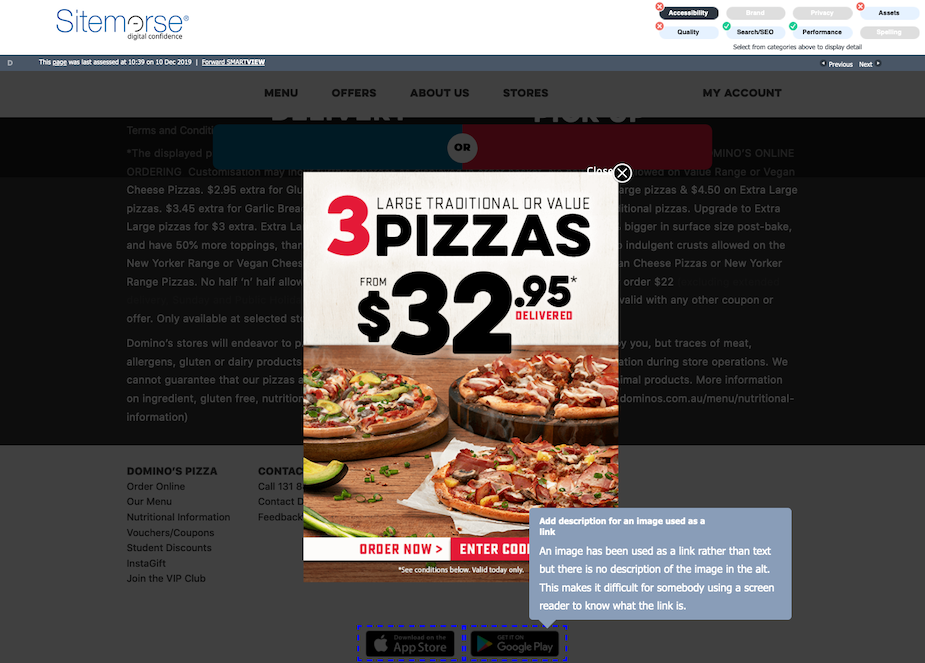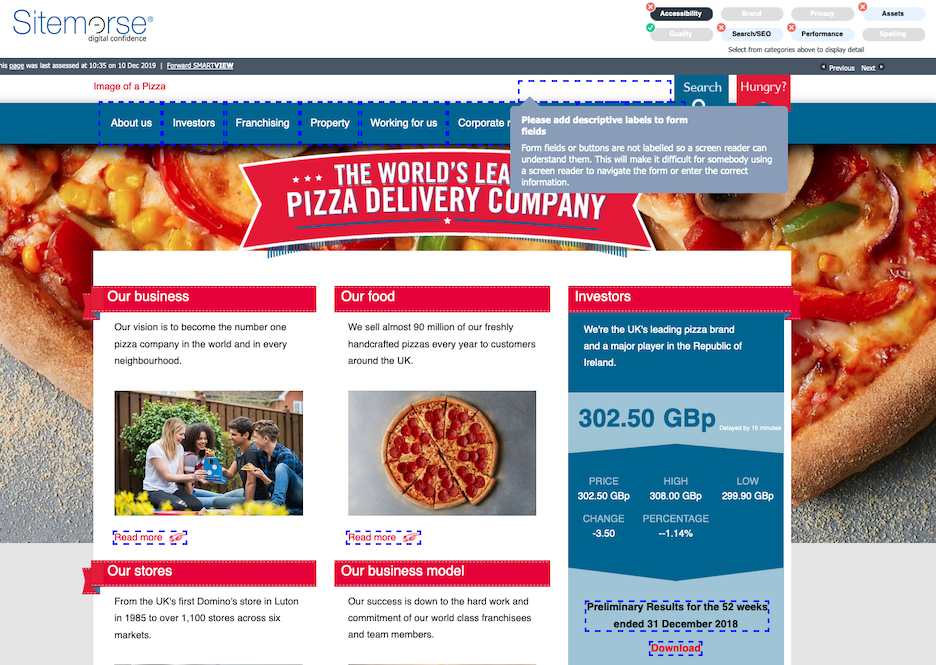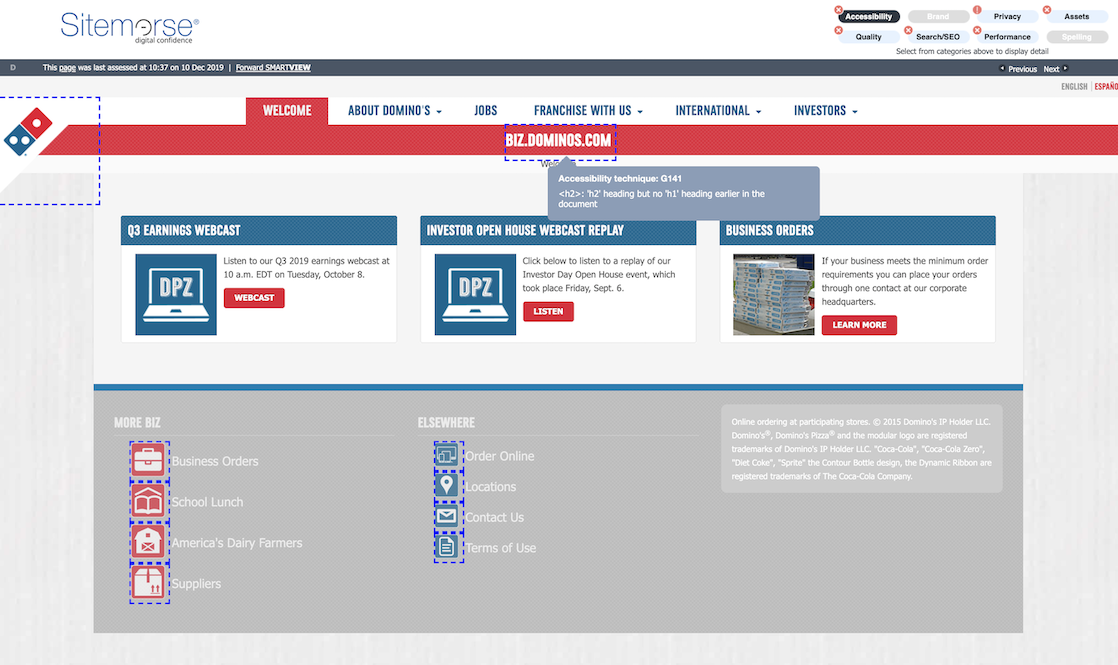20 Dec 2019 | Accessibility

The ongoing accessibility case involving Domino’s that has been dragged through the US lawcourts is almost a textbook example of how to damage your reputation and brand. Arguably the most high-profile accessibility case from the last year or so, the case has generated thousands of negative headlines and column inches. Although the case is in the US, the coverage is global, and it continues to generate international media attention. Remember, those headlines are now always there and cannot be undone, waiting to appear in any potential Google search. The Domino’s brand is now tainted as a large corporation who doesn’t care about disabilities; we certainly don’t envy the task ahead for the Domino’s PR department.
The case originated in 2016 when the company was sued by Guillermo Robles, a person with a visual disability who was unable to order a custom pizza from the website and app, due to his inability to use assistive technology. The case, referencing the 1990 Americans with Disabilities Act (ADA), has gone through various stages. The latest chapter was in October 2019 when the US Supreme court denied Domino’s petition to hear the case, leaving an existing judgement from a lower court standing. Unsurprisingly, the failed petition generated massive media attention, and more negative press.
In our view, Domino’s decision to fight the original ruling was very poor. The success of the original case looks pretty bad but arguing against it is even more damaging; a huge global corporation taking on a single visually impaired person resonates negatively on just about every level. Even if there were some merits to the case from a legal standpoint, or nuances around the detail, the vast majority of customers are going to see this as a classic “David Vs Goliath” scenario. Whatever angle you look at it, it doesn’t look good.
How to trash your brand
The question is, what can other organisations learn from this? Forgive the pun, but what are the takeaways?
On the surface, the actions from Domino’s are hard to fathom. How can it be possible for such a global brand that is so reliant on consumer trust to take such a stance? The home pizza delivery market is extremely competitive, particularly with entrants like Uber Eats and Deliveroo. Anything like this is negative on a players’ brand value and can have significant long-term damage. We are sure within Domino’s there will have been detailed analysis predicting what the actual cost to the bottom line may be. There is the old saying that there is “no such thing as bad publicity”, but in the age of social media amplification and an ethically savvy customer base, this simply doesn’t hold true any longer.
What should Domino’s have done differently?
Of course, the best action would have been to introduce measures that prevented the action in the first place. Domino’s should have taken digital accessibility compliance seriously in the first place, making sure all digital channels are AA compliant with WCAG (2.0 then, 2.1 now) guidelines, and then putting processes in place and investing in tools that maintain accessibility levels.
The next best action would have been to respond immediately and visibly to the original ruling. It’s ironic that the cost of just sorting out the website and apps would have been low to minimal for a global corporation, likely in low tens of thousands of dollars in development costs; just dealing with some simple flaws might have even been a few dollars if dealt with internally. The cost of reputational damage and legal costs will vastly exceed these costs many times over.
In responding immediately it’s also possible that Domino’s could have minimised the reputational damage; perhaps they could have made a statement about making a mistake, how they are now committed to improving accessibility and even making resolutions to lead in this space. When corporates are seen to respond swiftly and make necessary changes with tangible results, there can be surprising levels of goodwill from customers. It can even be an opportunity to get some good PR.
Domino’s websites still aren’t compliant!
The third and ultimately minimum response would be to at least do something now, particularly on the back of the response of the US Supreme Court in October.
However, it really doesn’t look like Domino’s have learned from this episode at all. Not only has there been the ongoing media attention, but the websites still look like they have some very basic accessibility issues that are entirely avoidable. We found some pretty fundamental issues when we ran our an automated accessibility assessment across a number of their pages.
For example, on the main Australian site some images that are used as links don’t have alt text so these won’t give a description of the image to screen reader users, failing accessibility.

On the Domino’s UK corporate site the descriptive labels on a form field are missing so a screen reader cannot understand them.

Furthermore, on the US Business site, we can see that there are multiple accessibility actions on the page, including the homepage not including a Heading 1 in the page but using Heading 2’s later on the page. Something we often see that is done for style reasons, but doesn’t enable screen reader users to navigate a page correctly.

These elementary issues are easy to fix but continue to expose Domino’s to risk. Given all that has happened, we find this extremely surprising.
What lessons can we learn?
To us the “takeaways” from the Domino’s saga for organisations seem clear cut.
- Organisations need to make digital accessibility compliance a priority. This is not about token efforts. it’s about taking your legal responsibilities seriously.
- Senior management need to be far more tuned into the actual risks of not dealing with accessibility. Don’t let poor advice lead you down a path where you’re just digging yourself into a deeper hole, trashing your reputation in the process.
- Processes need to put into place so that websites and apps are truly accessible. This requires ongoing effort, with investment in training, tools and people. The fact that basic issues are still taking place at Domino’s says a lot.
We bang on and on about digital accessibility for good reasons. It’s your legal and moral responsibility and it’s a reputational risk issue. Don’t be the next Domino’s, find out how Sitemorse can help.

